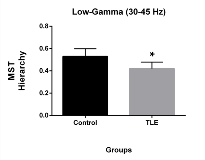Default Mode Network Displays Reduced Hierarchical Topology in Epilepsy Patients
Abstract number :
1.080
Submission category :
2. Translational Research / 2A. Human Studies
Year :
2018
Submission ID :
501957
Source :
www.aesnet.org
Presentation date :
12/1/2018 6:00:00 PM
Published date :
Nov 5, 2018, 18:00 PM
Authors :
Francinaldo L. Gomes, Universidade Federal do Para; José Fiel, Institute of Technology, Federal University of Pará, Belém (PA); Mylena Ferreira, Universidade Federal do Para; Eline Mesquita Melo, University Federal of Para; Rodrigo Pereira,
Rationale: Network analysis has proven to be an effective tool to describe the emerging patterns of organization of complex systems built of multiple interacting agents. This approach has also been applied in neuroscience to characterize how interacting neuronal groups distributed in the brain underlie human behavior. For instance, self-referential mental processing (freethinking) connects a specific set of brain regions into a large-scale default-mode network (DMN). One of the aims of network neuroscience is to explain the differences in brain network organization between healthy individuals and patients with distinct neurological disorders. In the present study, we sought to characterize the changes in the topology of the DMN of epileptic patients using electroencephalographic (EEG) recordings of brain electrical activity. Methods: Nine minutes of resting state EEG was recorded from 5 patients (33±12 years old) with a diagnostic of drug-resistant temporal lobe epilepsy (TLE). A control group comprised of 5 age-matched healthy subjects was submitted to the same procedure. EEG was recorded with a 22-channel system (Neuromap40i, Neurotec, Brazil) with a sampling frequency of 256 Hz and using Fpz as ground. Channels were referenced to the linked mastoids. The recordings were pre-processed to remove biological artifacts. Functional Connectivity (FC) between pairs of electrodes was estimated with the debiased weighted phase-lag index (dWPLI) method and based on four frequency ranges: theta (4-8 Hz), alpha (8-12Hz), beta (13-30Hz), and Low gamma (30-45Hz). We calculated a connectivity matrix for each subject and for each frequency range. Subsequently, the minimum spanning tree (MST) was measured in order to obtain the fundamental network properties. The MSTs were characterized by the normalized leaf fraction. Kappa value was also calculated to obtain the degree distribution and thus the resilience to attacks against the network. The diameter of the MST, which is largest distance between any two nodes, was also computed. The trade-off between large scale integration in the MST and the overload of central nodes was measured by the hierarchy value. Results: The functional connectivity of the two groups did not differ for theta, beta and alpha waves for any of the MST measured values (p>0.05, Mann-Whitney test). However, the hierarchic organization based on low-gamma connectivity was different groups (p=0.0317, Mann-Whitney test). The DMN network topology of TLE patients had significantly lower levels of MST hierarchy (0.432±0.058) than healthy participants (0.518±0.069) (see figure). Conclusions: Our findings reveal that healthy subjects present a more hierarchical DMN organization when compared with TLE patients. A higher degree of DMN hierarchy results in a more balanced and efficient topology, with less hub overload. The lower degree of DMN hierarchy observed in individuals with TLE suggests a shift towards a sub-optimal network organization. These results are consistent with previous reports showing that epilepsy correlates with an impairment of brain cortical networks. Funding: Non-governmental organization and University Federal of Para
